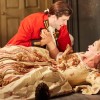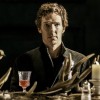The Blue Dragon, Robert LePage
reviewed for The Spectator, 22 February 2011
Few living artists compare to Robert LePage when it comes to balancing sparkling, sizzling, soul-boggling technical virtuosity with profound emotional punch. The actor-director’s productions are usually heartbreaking multi-media installations that play with the isolation at the heart of human life. As Ian Shuttleworth put it back in 1991, ‘see Robert LePage and die’.
LePage hasn’t killed me, but he nearly broke up my relationship: when my date, now my fiancé, failed to weep at a performance of The Anderson Project in 2005, I did wonder if I’d just become involved with a man without a soul. Evidently, the relationship survived, but it was touch and go for a while.
Against such expectations, many fans will find themselves initially disappointed by The Blue Dragon, a low-key tale of Canadians in contemporary China. Gone are the haunting images of previous productions: instead of the fragile, magical puppetry of one-man shows like The Far Side of the Moon (2000), we have the corporate design of a team of 20 technicians, resulting in static, large scale sets and video panoramas that wouldn’t have looked out of place in last year’s Leonard Cohen concerts. But despite the slow pace and clinical feel, The Blue Dragon emerges as a subtly reflective, melodic fable about the perils and possibilities of Western involvement with China. It’s a slow-burn piece, but well worth the wait.
LePage describes The Blue Dragon as ‘a spin-off, not a sequel’ to his six-hour masterwork, The Dragon Trilogy, the saga of two French-Canadian families and their entanglement with Chinese relatives throughout the 20th Century. Fear not, in order to engage with latest show there is no need to have seen the original piece, premiered as long ago as 1985. Since then, China’s relationship with the West has changed beyond recognition, and so has the lifestyle of central character, Pierre LaMontagne, now a jaded Canadian expat and smalltime art dealer.
Exhausted by the war of attrition waged by the local bureaucrats attempting to raze his neighborhood, LaMontagne is all but ready to leave when his ex, Claire, arrives in Shanghai to adopt a Chinese child – the next best thing, Pierre cruelly notes, to a white baby. Marie Machaud infuses Claire with surprising sympathy as a well-intentioned witness to Pierre’s entanglement with Xiao Ling, the younger artist he represents, watching as both partners gently exploit each other. The artistic material gives LePage a chance to mediate on one of his recurrent themes, the relationship between word and image, so there are promising demonstrations of the multi-layered metaphors inherent in Chinese calligraphy.
In the role of frustrated Xiao Ling, Tai Wei Foo is particularly impressive. But the image of her face, splashed repeatedly across the screens, becomes a symbol for the production’s complex relationship with the problem of emotional authenticity. Xiao Ling supposedly takes photographs of herself at moments of extreme emotion in her real life: we see these photographs as her ‘art’, but to us they will always be the face of an actress.
The Blue Dragon revels in such intellectual paradoxes. But, for all its brilliance, the abiding feeling left by LePage’s production remains one of uncomfortable, and uncharacteristic, detachment.






